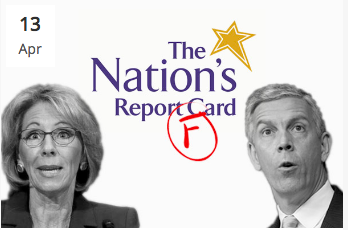Curator’s note: Marc Tucker is the President and CEO of the National Center for Education and Economics (NCEE) http://ncee.org. He has been a thought leader in education for years and is widely respected for enabling the ability to compare US education achievement with other countries. His observations are that the US has fallen in international education achievement rankings in math and reading while other countries have improved during the recent past. Below is his summary of the state of American education. He correctly points out that the US inability to address education as a competitive economic advantage dooms our country to “watch our citizens struggle . . . growing political instability . . . “. This is what we are facing today.
“What’s at Stake
The long-term results from the NAEP show no change at all in the scores of American high school students since the survey began more than 40 years ago. In the meantime, nearly 30 countries have overtaken the United States in achievement and equity, many by wide margins, even though the United States spends more per student than all but a handful of other industrialized countries. Our states will either choose to learn from the countries, states and provinces that are far ahead on the global stage, or watch their citizens struggle ever harder to make ends meet and face the growing political instability that will inevitably follow as we fail to give our workers the skills they need to be competitive. We offer this analysis of the strategies used by the top performers in the hope that it will be useful to the states that choose to meet the challenges presented by a greatly changed global economy and swiftly evolving digital technologies.”
. . .
If you want a more balanced, nuanced analysis of state performance on NAEP as revealed by the data, you should read the op-ed piece by John White, Louisiana’s Commissioner of Education, that appeared in the Washington Post about two months ago.
Regular readers of this blog will not be surprised by my take on this subject. The most important indicator of American student performance is not 4th grade NAEP or 8th grade NAEP. It is American students’ performance on PISA, an international comparative measure of the performance of 15-year-old students in 72 countries, including virtually all of the wealthiest countries as well as many others. The performance of American students on this assessment has been essentially flat since it was first administered in the year 2000. In math, 20 countries scored higher than the U.S. in that first year. Now, 36 countries have statistically significantly higher scores than the U.S in math. Students in the top-performing countries leave high school two to three years ahead of our students. A considerably larger fraction of their students performs in the top quarter of the PISA performance scale than is true of American students. And a larger fraction of American students performs in the lowest quarter of that scale than is true for these top performers. Which is to say that both our top performers and our lowest performers are way behind our competitors. And, by the way, remember that big gain in mathematics performance on NAEP that Arne Duncan referred to with such pride? Well, American students are further behind their counterparts on the PISA survey in mathematics than any other subject.




